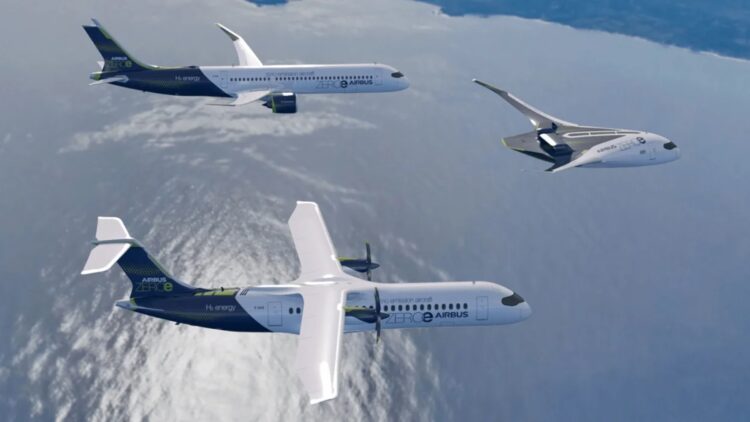This American airline will run 100 % on hydrogen: the project has begun, and the engines are colossal
Sustainable mobility, which we like to talk about so much, is not just for the roads. In Japan, they are already developing the first green ammonia ships, but in America, we have gone even further (literally). This airline has just announced that it will run 100% on hydrogen and is going to put it “in the air” (also literally). The project has just started, and the first engines have been presented, with something that has left the experts in shock: they are colossal. eco news
This American airline will run 100 % on hydrogen: the project has begun, and the engines are colossal
This is the first-ever engine better than hydrogen: 3 Japanese brands merge and shock the world
Bad news for America and Tesla EVs: India has unveiled the first steam engine ever seen
The end of hydrogen is this new freezing-fuel engine: Not known in America, but it’s the future
Sustainable mobility, which we like to talk about so much, is not just for the roads. In Japan, they are already developing the first green ammonia ships, but in America, we have gone even further (literally). This airline has just announced that it will run 100% on hydrogen and is going to put it “in the air” (also literally). The project has just started, and the first engines have been presented, with something that has left the experts in shock: they are colossal.
This American airline is switching to hydrogen: The project has begun, and it will change everything
The following announcement describes that American Airlines is making a massive leap toward a greener future of aviation by signing an agreement to acquire 100 hydrogen-electric motors conditionally from ZeroAvia, a prominent clean aviation firm. This significant partnership, together with the increased investment in ZeroAvia activity, proves the company’s readiness to switch to new fuels.
Hydrogen-electric engines adopted by ZeroAvia work in such a way that hydrogen is adopted in fuel cells to produce electricity, and the identified electricity is used to turn the electric propulsive motors of the airplane. This innovative approach results in only one emission during flight: The external stream is low-temperature water vapor.Hydrogen engines to run from the skies: Why this American project is so ambitious
Compared to traditional jet engines, these hydrogen-electric systems offer several key advantages:
Zero In-Flight Emissions
Lack of carbon emissions during the flight is the key plus for the aviation industry, which has been under pressure for its negative impact on the environment. This technology is quite encouraging and is on par with American Airlines’ ambitious plan to reduce absolute greenhouse gas emissions to zero by 2050.
However, initially, ZeroAvia plans to produce engines for 20-seat aircraft; however, the company designs engines for larger regional jets, like the Bombardier CRJ700 used by American Airlines on specific routes. Such scalability is instrumental in the commercial actualization of hydrogen-electric technology in the commercial aviation industry
ZeroAvia and American Airlines, to put on the skies the first 100 % hydrogen-powered aircraft
There are actionable targets for ZeroAvia regarding the hydrogen-electric systems’ deployment as well as development. It wants to achieve by the end of 2025 certification of its technology for 20-seat aircraft and up to 40 to 80-seat aircraft with a range of up to 700 miles by 2027.
As for the complete switch to hydrogen-electric engines in American Airlines’ fleet, which the company currently does not possess, it will take several years. Nevertheless, the feasibility and safety of these systems have been affirmed by the airlines. Some of the aircraft models that American has in its fleet include the Bombardier CRJ700 which the company operates on regional routes;
ZeroAvia is interested in converting these aircraft models to its larger engine. The latest investment by American Airlines in ZeroAvia after initially investing in the company back in 2022, once again shows the desire of this firm to ensure the creation of this revolutionary technology.
As you can see, these American Airlines hydrogen engines are the most revolutionary project we have presented to the world since the offshore wind farms in New York. Few brands had innovated with this fuel, with Rolls-Royce and Airbus as the only cases. However, we are not talking about airlines, which in the rest of the world are still very shy about zero-emission mobility; indeed, they have not even dared to use electric engines.
American Airlines’ Pioneering Hydrogen-Powered Aircraft Initiative
Sustainable mobility has become a buzzword in recent years, often associated with electric vehicles and eco-friendly public transportation. However, the aviation industry, notorious for its significant carbon footprint, is making strides toward a greener future. In an unprecedented move, American Airlines has announced its ambitious plan to transition to 100% hydrogen-powered aircraft. This initiative represents a monumental leap in clean aviation technology and has the potential to revolutionize the industry.
Hydrogen-Powered Aviation: The Basics
Hydrogen-powered engines, unlike traditional jet engines, rely on hydrogen fuel cells to generate electricity. These cells convert hydrogen into electricity, which then powers electric propulsive motors. The only byproduct of this process is low-temperature water vapor, making it an incredibly clean technology. ZeroAvia, a leader in clean aviation technology, has partnered with American Airlines to supply these hydrogen-electric motors. This collaboration is set to significantly reduce the environmental impact of air travel.
American Airlines and ZeroAvia: A Historic Partnership
In a bid to lead the charge toward zero-emission aviation, American Airlines has conditionally agreed to acquire 100 hydrogen-electric motors from ZeroAvia. This partnership is not just a business deal but a commitment to sustainability and innovation. By investing in ZeroAvia, American Airlines is positioning itself at the forefront of green aviation.
The Advantages of Hydrogen-Electric Engines
The hydrogen-electric engines developed by ZeroAvia offer several compelling advantages over traditional jet engines:
- Zero In-Flight Emissions: The most significant benefit is the elimination of carbon emissions during flight. This is a crucial step in addressing the aviation industry’s contribution to global greenhouse gas emissions.
-
Reduced Noise Pollution: Hydrogen-electric engines are quieter than conventional jet engines, leading to less noise pollution, especially around airports.
-
Improved Energy Efficiency: These engines are designed to be more energy-efficient, which can result in lower operational costs over time.
Initial Implementation and Future Plans
ZeroAvia plans to initially produce engines for 20-seat aircraft. However, the company has ambitious plans to scale up its technology for larger regional jets, such as the Bombardier CRJ700, which American Airlines currently operates on certain routes. By 2025, ZeroAvia aims to certify its technology for 20-seat aircraft. By 2027, the goal is to expand to 40 to 80-seat aircraft with a range of up to 700 miles.
Challenges and Feasibility
While the transition to hydrogen-electric engines is promising, it is not without challenges. Developing the infrastructure to support hydrogen refueling at airports is a significant hurdle. Additionally, ensuring the safety and reliability of these new engines will require rigorous testing and certification processes. However, the potential environmental benefits make overcoming these challenges worthwhile.
A Look at the Competition
Globally, few companies have ventured into hydrogen-powered aviation. Rolls-Royce and Airbus are notable exceptions, both of which have developed hydrogen-based technologies. However, most airlines have been hesitant to adopt zero-emission mobility solutions, often sticking to traditional jet engines. American Airlines’ bold move sets it apart as a pioneer in this space.
The Broader Impact on the Aviation Industry
American Airlines’ initiative is more than just a technological advancement; it signals a shift in the aviation industry’s approach to sustainability. As one of the largest airlines in the world, American Airlines’ commitment to hydrogen-powered engines could influence other airlines to follow suit. This could accelerate the adoption of clean aviation technologies globally.
Long-Term Environmental Goals
American Airlines has set an ambitious goal to achieve net-zero greenhouse gas emissions by 2050. The adoption of hydrogen-electric engines is a critical component of this strategy. By reducing its carbon footprint, American Airlines aims to contribute significantly to global efforts to combat climate change.
American Airlines’ commitment to hydrogen-powered aviation marks a significant milestone in the journey toward sustainable air travel. Through its partnership with ZeroAvia, the airline is taking a bold step to address the environmental impact of aviation. While challenges remain, the potential benefits of hydrogen-electric engines make this an exciting development for the industry. As the project progresses, it will be closely watched by industry experts and environmentalists alike, eager to see how this innovative technology can reshape the future of aviation.
This move by American Airlines not only showcases its dedication to sustainability but also sets a precedent for the entire industry. With continuous advancements and investments in clean aviation technologies, the dream of zero-emission air travel is becoming a reality, bringing us closer to a greener and more sustainable future.






